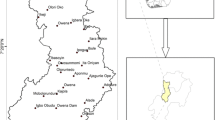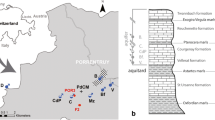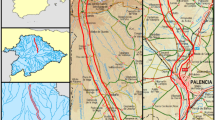Abstract
This study undertook a structural discretisation as a first-order and pilot framework to understand groundwater–stream connectivity at a local to reach scale. Structural discretisation was used as the categorisation of hydrogeological landscapes, where areas having relatively uniform geology and hydrogeological characteristics were conceived of as a single-hydrologic landscape. The results of the study led to the development of reach-scale groundwater–stream typologies, a new paradigm recommended as a first-order and pilot tool to establish a groundwater–surface water interaction framework in similar settings. The typology on the southeastern side reach of the study area is the lateral contact type where groundwater enters the riparian area aquifer from the terrestrial area aquifer through the laterally continuous alluvial gravel sequence. Therefore, over-abstraction from the terrestrial and/or riparian area aquifer may result in the loss of baseflow into the river. The confined contact-type typology operates on the northern reach where the groundwater–surface exchange primarily takes place between the stream and the riparian area aquifer because, due to low-hydraulic conductivities, the terrestrial area aquifer only permits little groundwater to enter or leave the terrestrial area aquifer. In this case, progressive over-abstractions from the riparian area will primarily draw water originating from the stream through transmission losses, resulting in progressively induced stream infiltration. Consequently, groundwater–surface water interaction typologies can also play a key role in the formulation of conjunctive water resource management for greater water supply security and stability.


















Similar content being viewed by others
References
Aggarwal PK, Froehlich K, Kulkarni KM (2007) Environmental isotopes in groundwater studies. In: Silveira L, Usunoff EJ (eds) Groundwater—encyclopedia of live support systems. EOLSS Publishers/UNESCO, Paris, pp 69–92
Bestland E, George A, Green G, Olifent V, Mackay D, Whalen M (2017) Groundwater dependent pools in seasonal and permanent streams in the Clare Valley of South Australia. J Hydrol Reg Stud 9:216–235
Botha JF (1998) Karoo aquifers, their geology, geometry and physical properties. WRC report no; 487/1/98. Water Research Commission, Pretoria
Bouwer H, Rice RC (1976) A slug test for determining hydraulic conductivity of unconfined aquifers with completely or partially penetrating wells. Water Resour Res 12:423–428
Brodie R, Sundaram B, Tottenham R, Hostetler S, Ransley T (2007) An overview of tools for assessing groundwater-surface water connectivity. Bureau of Rural Sciences, Canberra
Craig H (1961) Isotopic variations in meteoric waters. Science 133:1702–1703
Dahl MB, Nilsson B, Langhoff JH, Refsgaard JC (2007) Review of classification systems and new multi-scale typology of groundwater–surface water interaction. J Hydrol 344:1–16
Demiroğlu M (2017) Identifying the groundwater basin boundaries using environmental isotopes: a case study. Appl Water Sci 7:1161–1167
Freeze RA, Witherspoon PA (1967) Theoretical analysis of regional groundwater flow, II: effect of water table configuration and subsurface permeability variations. Water Resour Res 3:623–634
Gomo M, van Tonder GJ, Steyl G (2013) Investigation of the hydrogeochemical processes in an alluvial channel aquifer located in a typical Karoo Basin of Southern Africa. Environ Earth Sci 70:227–238
Hoefs J (2004) Stable isotope geochemistry. Springer, Germany
Huff DD, Oneill RV, Emanuel WR, Elwood JW, Newbold JD (1982) Flow variability and hillslope hydrology. Earth Surf Proc Land 7:91–94
Kalbus E (2009) Spotlight on heterogeneity: measuring and modelling stream–aquifer interactions. Thesis, University of Neuchâtel
Kalbus E, Reinstorf F, Schirmer M (2006) Measuring methods for groundwater–surface water interactions: a review. Hydrol Earth Syst Sci 10:873–887
Landon MK, Rus DL, Harvey FE (2001) Comparison of in-stream methods for measuring hydraulic conductivity in sandy streambeds. Groundwater 39:870–885
Loke MH, Barker RD (1996) Rapid least-squares inversion of apparent resistivity pseudosections by a quasi-Newton method. Geophys Prospect 44:131–152
Madioune DH, Faye S, Orban P, Brouyere S, Dassargues A, Mudry J, Stumpp C, Maloszewski P (2014) Application of isotopic tracers as a tool for understanding hydrodynamic behaviour of the highly exploited Diass aquifer system (Senegal). J Hydrol 511:443–459
Magee JW (2009) Palaeovalley groundwater resources in arid and semi-arid Australia: a literature review. National Water Commission, Geoscience Record 2009/03:224
Meyer PS (2003) An explanation of the 1:500 000 general hydrogeological map. In: Bloemfontein 2924. Geohydrology, Department of Water Affairs & Forestry, Pretoria, Directorate
Nanson GC, Croke JC (1992) A genetic classification of floodplains. Geomorphology 4:459–486
Nowinski DJ, Cardenas MB, Lightbody AF (2011) Evolution of hydraulic conductivity in the floodplain of a meandering river due to hyporheic transport of fine materials. Geophys Res Lett 38:L01401
Palmer MA (1993) Experimentation in the hyporheic zone: Challenges and prospectus. J N Am Benthol Soc 12:84–93
Payne RR (1990) The use of stable isotope tracers for the estimation of the direction of groundwater flow. J Hydrol 112:395–401
Ritter DF, Kinsey WF, Kauffman ME (1973) Overbank sedimentation in the Delaware River valley during the last 6,000 years. Science 179:374–375
Shakhane T, Fourie FD, Du Preez PJ (2017) Mapping riparian vegetation and characterising its groundwater dependency at the Modder river government water scheme. Groundw Sustain Dev 5:216–228
Sophocleous M (2002) Interactions between groundwater and surface water: the state of the science. Hydrogeol J 10:52–67
Sophocleous M (2003) Environmental implications of intensive groundwater use with special regard to stream and wetlands. In: LIamas MR, Cursodio E (eds) Intensives use of groundwater. A.A. Balkema, Lisse, pp 93–112
Uchida T, Asano Y, Onda Y, Miyata S (2005) Are headwaters just the sum of hillslopes? Hydrol Process 19:3251–3261
Wen DG (2002) Application of the environmental isotopes to study on the attribution of regional groundwater resources. Earth Sci 27:141–147
Winter TC (2001) The concept of hydrological landscapes. J Am Water Resour Assoc 37:335–349
Winter TC, Harvey JW, Franke OL, Alley WM (1998) Ground water and surface water: a single resource, vol 1139. DIANE Publishing Inc., Darby, PA
Wolman MG, Leopold LB (1957) River floodplains: some observations on their formation. US Geol Surv Prof pap 282C:87–107
Wolock DM, Fan J, Lawrence GB (1997) Effects of basin size on low-flow stream chemistry and subsurface contact time in the Neversink River watershed. Hydrol Process 11:1273–1286
Woodford AC, Chevallier L (2002) Hydrogeology of the Main Karoo Basin: Current knowledge and future research needs. Water Research Commission report no. TT 179/02. Pretoria, South Africa
Acknowledgements
This study has been undertaken as part of the the South African Water Research Commission (WRC) project titled groundwater–surface water interactions: from theory to practice (K5/254/1). Therefore, the financing of the project by WRC is gratefully acknowledged. The authors also wish to acknowledge Mr. Tlali Shakhane for his help during both the geophysical survey and the entire sampling program. We wish to thank also Prof. Simon Lorentz and Mr. Cubus Pretorius who undertook most of the isotope analysis for this research. We greatly appreciate and value the recommendations and criticism of the reviewers (Dr. RC Jain and anonymous) and really acknowledge they served to make the manuscript better.
Author information
Authors and Affiliations
Corresponding author
Rights and permissions
About this article
Cite this article
Shakhane, T., Fourie, F.D. An investigation into structural discretisation as a first-order and pilot framework to understand groundwater–stream water connectivity at a reach scale. Sustain. Water Resour. Manag. 5, 883–900 (2019). https://doi.org/10.1007/s40899-018-0267-z
Received:
Accepted:
Published:
Issue Date:
DOI: https://doi.org/10.1007/s40899-018-0267-z




